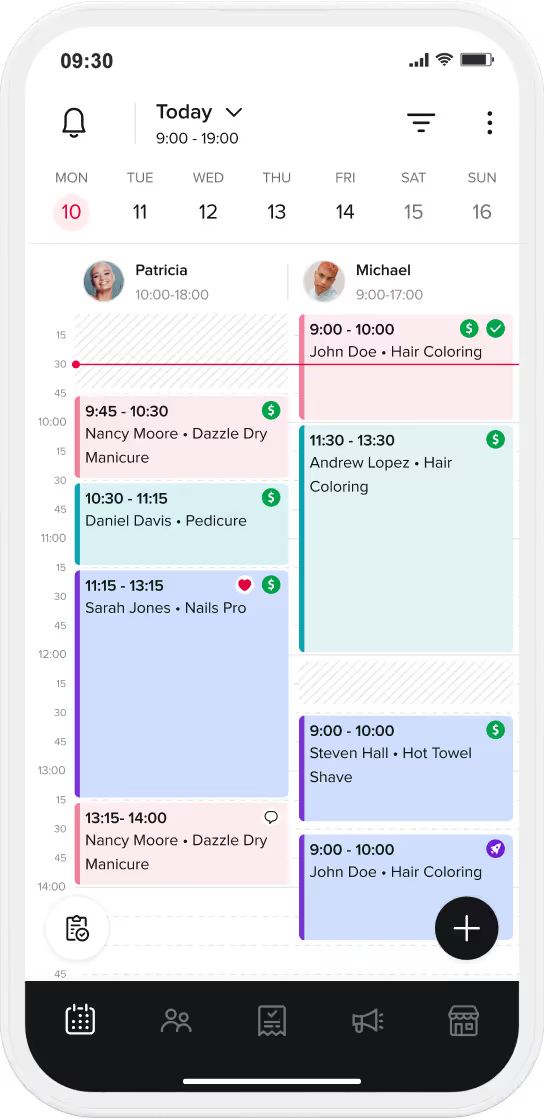

The hum of dryers, the snip of scissors, the satisfied smiles of clients – these are the sounds of a thriving salon. But behind the scenes, orchestrating this symphony of beauty and service is often a linchpin: the barber or stylist and their trusty clippers. From crisp fades to precise trims, your clippers are instrumental in delivering the quality and style your clients expect. But just like any finely tuned instrument, your clippers require diligent care to perform at their peak. This comprehensive guide delves into the essential practices of clipper care for professionals, going far beyond a simple wipe-down. We’ll explore the vital routines and techniques that ensure your clippers remain sharp, reliable, and a testament to your commitment to your craft. Neglecting this crucial aspect can lead to frustratingly dull blades, uncomfortable overheating, and even untimely breakdowns, ultimately impacting your efficiency and professional reputation.
Consistent clipper maintenance offers a multitude of benefits that directly impact your daily work and the longevity of your valuable tools:
Sharp, clean blades glide effortlessly through hair, ensuring precise and even cuts. This translates to better results for your clients, faster service times, and less strain on your hands.
Hair, product residue, and debris can cause friction and corrosion, leading to premature wear and tear on your expensive clipper blades. Regular cleaning and oiling significantly extend their lifespan, saving you money in the long run.
The motor and internal mechanisms of your clippers can be stressed by excessive friction and overheating caused by neglected blades. Proper maintenance helps prevent these issues, ensuring the overall durability and reliability of your clippers.
In a profession that involves close contact, maintaining impeccable hygiene is paramount. Disinfecting your clippers between each client is not just good practice – it’s a crucial responsibility for preventing the spread of bacteria, fungi, and other potential contaminants, safeguarding both your clients and yourself.
Well-maintained tools speak volumes about your professionalism and attention to detail. Clients notice these things, and clean, smoothly operating clippers contribute to a positive perception of your services.

Establishing a simple yet effective daily routine after each client is the first line of defense in proper clipper care:
Immediately after finishing a cut, use a stiff cleaning brush (often one comes with your clippers) to thoroughly brush away all loose hair from the blades, clipper head, and housing. Don't underestimate the amount of hair that can accumulate in these areas.
Use a clean, slightly damp cloth (or a dry cloth for delicate finishes) to wipe down the exterior of the clipper body. This removes product residue, dust, and any other debris that may have accumulated during the service.
For particularly thick or product-heavy hair, a quick blast of compressed air specifically designed for electronics or a fine-bristled brush can help dislodge stubborn hair particles trapped between the blades.
A more thorough deep cleaning should be performed regularly, ideally at the end of each workday or at least a few times a week, depending on usage:
You will need: a stiff cleaning brush (various sizes if possible), clipper oil specifically designed for hair clippers, a disinfectant solution (options include clipper-specific disinfectant sprays or diluted isopropyl alcohol - ensure it's at least 70% concentration), a clean, lint-free cloth, and a small screwdriver if your clipper blades are detachable.
Always ensure your clippers are completely powered off and unplugged from the power source before beginning any cleaning or maintenance. Safety first!
If your clippers have detachable blades, carefully remove them according to the manufacturer's instructions. This allows for more thorough cleaning of both the blades and the clipper head.
Using your cleaning brush and compressed air, meticulously remove all trapped hair from both the blades (especially between the teeth) and the clipper head. Pay close attention to crevices and moving parts.
Use your cleaning brush and a small amount of clipper cleaning solution or a few drops of diluted alcohol on the brush to gently scrub away any remaining hair, product buildup, or debris from the blades.
Never submerge your clipper blades directly in water. Water can lead to rust and corrosion, significantly damaging the blades and hindering their performance. While you might have heard about washing clippers in water, it's a harmful practice that professionals should avoid.
Using a cloth dampened with diluted isopropyl alcohol (at least 70%) is an effective way to clean clipper blades and remove residue. Ensure the blades are dry after cleaning with alcohol to prevent potential corrosion over time. Remember to use sparingly and avoid getting alcohol into the clipper motor.
Use a clean cloth dampened with clipper cleaning solution or diluted alcohol to wipe down the entire clipper head and housing. Pay attention to areas where product or hair might accumulate. Ensure it's dry before reassembling.
This is a crucial step for hygiene. Apply a clipper-specific disinfectant spray liberally to both the blades and the clipper head, ensuring all surfaces are coated. Allow the disinfectant to sit for the contact time specified on the product label (usually around 10 minutes) to effectively kill bacteria and viruses. Alternatively, you can carefully wipe down the blades and head with a cloth dampened with 70% isopropyl alcohol (at least 70%) and allow it to air dry completely.
After cleaning and disinfecting, lubrication is essential for smooth operation and blade longevity. Apply 1-2 drops of clipper oil to the teeth and along the sides of the blades, following the manufacturer's instructions. Turn the clippers on briefly to allow the oil to distribute evenly. Wipe off any excess oil with a clean cloth.
Carefully reattach the blades to the clipper head, ensuring they are properly aligned according to the manufacturer's instructions. Incorrect alignment can lead to uneven cuts and potential pinching.
Give the entire clipper a final wipe down with a clean, dry cloth to remove any fingerprints or remaining residue.
Beyond the regular cleaning routine, consider these additional maintenance practices:
Regularly check the alignment of your clipper blades. Misaligned blades can cause uneven cutting, pulling, and discomfort for your clients. Most clippers have adjustment screws; consult your clipper's manual for instructions on proper alignment.
Treat your clipper cord with care. Avoid twisting or wrapping it tightly, which can damage the internal wires. Store your clippers with the cord loosely coiled or hanging freely.
Even with meticulous cleaning and oiling, clipper blades will eventually dull with use. The frequency of sharpening depends on the amount of use and the types of hair you cut. Invest in professional blade sharpening services to maintain optimal cutting performance. Dull blades strain the motor and can damage hair.
Store your clippers in a clean, dry place, preferably in a case or pouch, to protect them from dust, damage, and accidental drops.
Recognizing and addressing common clipper problems can save you time and frustration:
If your clippers are pulling hair, leaving uneven cuts, or requiring more passes to achieve the desired result, the blades are likely dull and need sharpening or replacement.
Overheating can be caused by a lack of lubrication, excessive trapped hair, or prolonged use. Ensure you are regularly cleaning and oiling your clippers and avoid continuous use for extended periods without allowing them to cool down.
This can be a sign of dull or misaligned blades. Check the alignment first and then consider sharpening or replacing the blades if the issue persists.
Investing in quality clipper cleaning products is essential for proper maintenance:
Opt for brushes with stiff bristles that can effectively remove hair without damaging the clipper components. Consider having different sizes for various parts.
Use only oil specifically designed for hair clippers. These oils are typically light and non-greasy, providing the necessary lubrication without causing buildup. Avoid using household oils like WD-40, which are not suitable for this purpose and can damage your clippers.
Choose either a reputable clipper-specific disinfectant spray or use diluted isopropyl alcohol (at least 70%). Always follow the manufacturer's instructions for contact time and safe usage.
As a dedicated professional, your tools are an extension of your skill and a reflection of your commitment to excellence. Mastering the art of clipper care is not merely a chore; it's an integral part of your craft. By implementing a consistent and thorough maintenance routine, you are investing in the longevity and optimal performance of your clippers, ensuring precise cuts, maintaining impeccable hygiene, and ultimately upholding the highest standards of your profession. Take pride in your tools, and they will continue to serve you and your clients with precision and reliability for years to come.
The most critical step is regular oiling and cleaning. Lubrication reduces friction and overheating, which are the main causes of premature wear, corrosion, and motor strain.
Submerging blades in water is harmful because it leads to rust and corrosion, significantly damaging the metal and hindering the cutting performance and overall longevity of the blades.
You should use a reputable clipper-specific disinfectant spray or wipe the blades with a cloth dampened with 70% or higher isopropyl alcohol. Always follow the product's required contact time.
Two common signs that the blades are dull are the clippers pulling or snagging the client's hair during the cut, and the need to make more passes to achieve the desired result.
Well-maintained, clean, and smoothly operating tools contribute to a positive and professional image, assuring clients of the stylist's attention to detail and commitment to hygiene.

